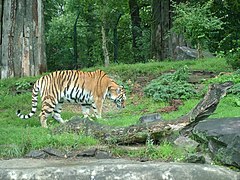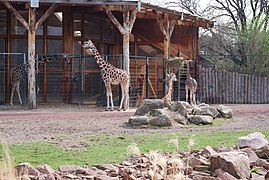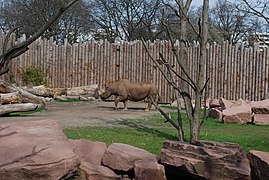
Hanover Zoo is located in the city centre, or Mitte borough, of Hanover, Germany. The zoo was established on 4 May 1865, and comprises an area of 22 hectares. It contains about 3,414 animals in 237 species, which are cared for by more than 400 employees in the summer season.

The Moscow Zoo or Moskovsky Zoopark is a 21.5-hectare (53-acre) zoo, the largest in Russia.

Hellabrunn Zoo is a 40 hectare zoological garden in the Bavarian capital of Munich. The zoo is situated on the right bank of the river Isar, in the southern part of Munich near the quarter of Thalkirchen.

The Berlin Zoological Garden is the oldest surviving and best-known zoo in Germany. Opened in 1844, it covers 35 hectares and is located in Berlin's Tiergarten. With about 1,380 different species and over 20,200 animals, the zoo presents one of the most comprehensive collections of species in the world.

Copenhagen Zoo is a zoological garden in Copenhagen, Denmark. Founded in 1859, it is one of the oldest zoos in Europe and is a member of EAZA. It comprises 11 hectares and is located in the municipality of Frederiksberg, sandwiched between the parks of Frederiksberg Gardens and Søndermarken. With 1,571,331 visitors in 2019 it is the most visited zoo and one of the most visited attractions in Denmark. The zoo is noted for its new Elephant House designed by British architect Sir Norman Foster. The zoo maintains and promotes a number of European breeding programmes.

Leipzig Zoological Garden, or Leipzig Zoo is a zoo in Leipzig`s district Mitte, Germany. It was first opened on June 9, 1878. It was taken over by the city of Leipzig in 1920 after World War I and now covers about 27 hectares and contains approximately 850 species. By 2020, the zoo featured six different theme worlds, aiming at providing habitats appropriate for the species on display.
Zoo Landau in der Pfalz is a 4-hectare (9.9-acre) zoo in Landau in der Pfalz, Germany. It was founded in 1904. The governing body is the municipality of the city of Landau in der Pfalz (Landau/Palatinate/Germany). The zoo is situated in the city center, along the historic remains of a French fort. The average yearly number of paying visitors is between 155,000 and 170,000. The zoo is home to about 600 animals representing 110 species of mammals, birds, reptiles, amphibians, fish, and invertebrates. The current total number of employees is 20.
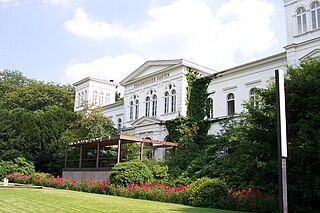
Wuppertal Zoo is a 24-hectare (59-acre) zoo in Wuppertal, Germany. About 5,000 animals from around the world live at the zoo, representing about 500 species, including apes, monkeys, bears, big cats, elephants, as well as birds, reptiles, and fish.

The Warsaw Zoological Garden, known simply as the Warsaw Zoo, is a scientific zoo located alongside the Vistula River in Warsaw, Poland. Opened in 1928, the zoo covers about 40 hectares in central Warsaw, and sees over 700,000 visitors annually, making it one of the most popular zoos in Poland. It is home to over 11,000 animals representing more than 500 species.

Ústí nad Labem Zoological Gardens is a zoo located on the edge of Krásné Březno, close to the centre of the city of Ústí nad Labem in the Czech Republic. The gardens cover an area of 26 ha, and lets visitors view rare and endangered species of animals such as orangutans, Somali donkeys, rhinoceroses, and Malaysian sun bears. Open throughout the year, the gardens host regular displays—the training of sea lions, a parade of elephants through the gardens, flying display of birds of prey, rides on ponies, and a range of other activities.

The Madrid Zoo Aquarium is a 20-hectare (49-acre) zoo and aquarium located in the Casa de Campo in Madrid, Spain. The zoo is owned by the city, but is managed by the international entertainment operator Parques Reunidos. Opened in 1770, it is one of the largest zoos in Spain and one of the few zoos in the world that houses giant pandas.

Al Ain Zoo, also "Al Ain Wildlife Park & Resort" or simply "Al Ain Wildlife Park", is a 400-hectare (990-acre) zoo located in the foothills of Jebel Hafeet in Al Ain, Abu Dhabi, the United Arab Emirates. It is primarily composed of ungulates and herbivores, such as Arabian antelopes. It also holds oryx, eland, gazelle, and lechwe, as well as the rare white lion and Nubian giraffe.

Dresden Zoo, or Zoo Dresden, is a zoo in the city of Dresden, Germany. It was opened in 1861, making it Germany's fourth oldest zoo. It was originally designed by Peter Joseph Lenné.

Rostock Zoo is a zoo in the city of Rostock, founded in 1899. It covers 56 hectares and with 4,500 animals from 320 species, Rostock Zoo is the largest zoo on the German east coast. Rostock Zoo is studbook keeper of Polar bears within the European Endangered Species Programme. The director of Rostock Zoo is Udo Nagel.

The Kaiserslautern Zoo is a zoo in the city of Kaiserslautern in Germany. The Zoo was founded on June 15, 1968, and is located in Kaiserslautern's Siegelbach neighbourhood. The zoo originally belonged to the town of Siegelbach which became part of the city in 1969.
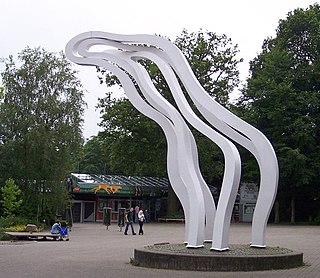
The Allwetterzoo Münster is a Zoo in Münster in Westfalen, Germany.

The Saarbrücken Zoo is with over 200.000 visitors annually, and over 1.700 animals from 160 Species the largest Zoo in Saarland. The Zoo is specialized in African animals.

The Opel Zoo is a zoo in Königstein im Taunus, Hesse in Germany.

The Chemnitz Zoo is a zoo in the city Chemnitz in Sachsen, Germany.

The Görlitz Zoo is a zoo in Görlitz, in Saxony, Germany.



